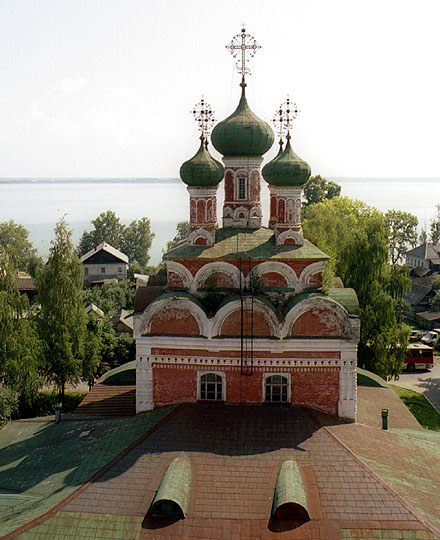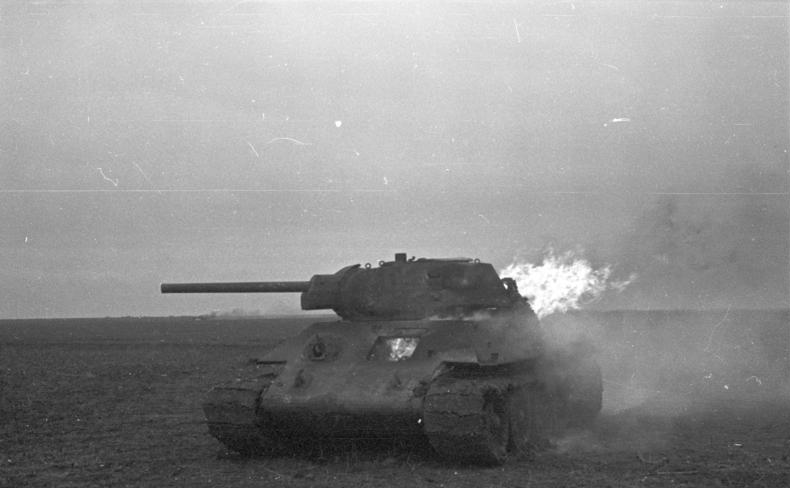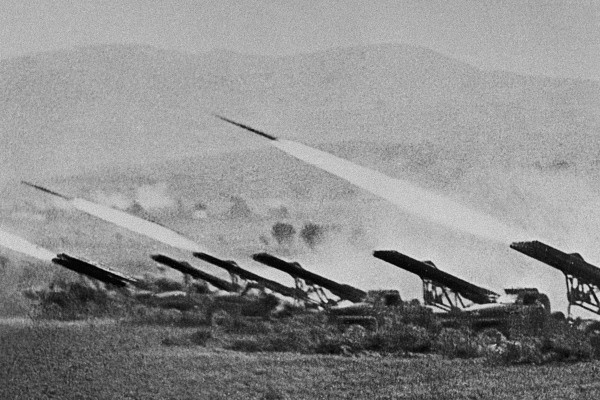|
257th Rifle Division (November 1941 Formation)
The November 1941 formation of the 257th Rifle Division was an infantry division of the Red Army, the second unit to bear the designation during World War II. The division joined the 3rd Shock Army and was sent into battle in the Toropets–Kholm offensive in January 1942. Following the conclusion of the offensive, the 257th defended positions northeast of the city of Velikiye Luki for much of the year. For distinguishing itself during the Battle of Velikiye Luki in late 1942 and early 1943, the division was reorganized as the 91st Guards Rifle Division in April 1943. Formation and Toropets–Kholm Offensive The 257th Rifle Division (second formation) was formed in Kalinin Oblast during November and December 1941, under the command of Major General Karp Zheleznikov. The division began forming in accordance with a directive of the Northwestern Front dated 8 November 1941 in the area of Kuzhenkino and Yedrovo. Its units reused the same numbers as the previously disbanded first for ... [...More Info...] [...Related Items...] OR: [Wikipedia] [Google] [Baidu] |
Red Army
The Workers' and Peasants' Red Army (Russian: Рабо́че-крестья́нская Кра́сная армия),) often shortened to the Red Army, was the army and air force of the Russian Soviet Federative Socialist Republic and, after 1922, the Union of Soviet Socialist Republics. The army was established in January 1918. The Bolsheviks raised an army to oppose the military confederations (especially the various groups collectively known as the White Army) of their adversaries during the Russian Civil War. Starting in February 1946, the Red Army, along with the Soviet Navy, embodied the main component of the Soviet Armed Forces; taking the official name of "Soviet Army", until its dissolution in 1991. The Red Army provided the largest land force in the Allied victory in the European theatre of World War II, and its invasion of Manchuria assisted the unconditional surrender of Imperial Japan. During operations on the Eastern Front, it accounted for 75–80% of casual ... [...More Info...] [...Related Items...] OR: [Wikipedia] [Google] [Baidu] |
Ostashkov
Ostashkov (russian: Оста́шков) is a types of inhabited localities in Russia, town and the administrative center of Ostashkovsky District in Tver Oblast, Russia, on a peninsula at the southern shore of Lake Seliger, west of Tver, the administrative center of the oblast. Population: History Early developments The island of Klichen was first mentioned in a letter sent by Grand Duke Algirdas of Lithuania to the Ecumenical Patriarch of Constantinople in 1371. After the island was pillaged by ushkuiniks, Novgorod pirates several years later, two of Klichen's surviving inhabitants, Ostashko and Timofey, moved to the mainland, where they founded the villages Ostashkovo and Timofeyevo, respectively. The former belonged to the Patriarch of Moscow and all Rus', Moscow Patriarchs, and the latter—to the Joseph-Volokolamsk Monastery. In 1770, both villages were merged into the town of Ostashkov. Ostashkov is commonly regarded as one of the finest Russian provincial towns. Its mai ... [...More Info...] [...Related Items...] OR: [Wikipedia] [Google] [Baidu] |
Infantry Divisions Of The Soviet Union In World War II
Infantry is a military specialization which engages in ground combat on foot. Infantry generally consists of light infantry, mountain infantry, motorized infantry & mechanized infantry, airborne infantry, air assault infantry, and marine infantry. Although disused in modern times, heavy infantry also commonly made up the bulk of many historic armies. Infantry, cavalry, and artillery have traditionally made up the core of the combat arms professions of various armies, with the infantry almost always comprising the largest portion of these forces. Etymology and terminology In English, use of the term ''infantry'' began about the 1570s, describing soldiers who march and fight on foot. The word derives from Middle French ''infanterie'', from older Italian (also Spanish) ''infanteria'' (foot soldiers too inexperienced for cavalry), from Latin '' īnfāns'' (without speech, newborn, foolish), from which English also gets '' infant''. The individual-soldier term ''infantry ... [...More Info...] [...Related Items...] OR: [Wikipedia] [Google] [Baidu] |
Mikhail Ozimin
Mikhail Ivanovich Ozimin (; 11 September 1898 – 25 August 1946) was a Soviet Army lieutenant general and a Hero of the Soviet Union. Early life and Russian Civil War Ozimin was born on 11 September 1898 at the station of Kropachyovo on the Samara–Zlatoust Railway in Ufa Governorate. During the Russian Civil War, he joined the Asha-Balashov Factory Red Guard detachment in November 1917, and in December he became a member of the Ufa Governorate Council of Combat Organizations of People's Armament (BONV), and from March 1918 was head of the office of the council. Ozimin joined the Bogoyavlensky Factory Red Guard Detachment in May and in September joined the Red Army, serving as adjutant and clerk in the personnel section of the 269th Bogoyavlensky Regiment. From August 1920 Ozimin studied at the Omsk Higher Military School and upon graduation from December 1921 commanded the 14th, 15th, and 16th Separate Special Purpose Battalion. In June 1922 he became commander of the Force ... [...More Info...] [...Related Items...] OR: [Wikipedia] [Google] [Baidu] |
2nd Mechanized Corps (Soviet Union)
The 2nd Mechanised Corps was a formation in the Soviet Red Army during the Second World War. First formation (June 1940 – Aug 1941) Initially formed in June 1940 in response the German victories of 1940 it was attached to the Odessa Military District, & attached to the 9th Army in the Odessa Fortified Region in Soviet Union It was under the command of Lieutenant General Iu. V. Novoselsky when the German Operation Barbarossa began in June 1941. It initially comprised the 11th and 16th Tank Divisions, & the 15th Mechanized Division. On 22 June 1941 2nd Mechanized Corps comprised 32,396 men, 517 tanks, 186 armoured cars, 162 artillery pieces, 189 mortars, 3794 vehicles, 266 Tractors & 375 Motorcycles including lighter models T-26, Bt 7, & T-28's & 60 of the newer T-34 & KV-1 models. On 22 July 1941 2nd Mechanized Corps consisted of 11th Tank Division 181 (81 Operational) tanks, 1070 vehicles & 71 tractors. 16th Tank Division with 99 tanks, 870 vehicles & 16 tractors & 15t ... [...More Info...] [...Related Items...] OR: [Wikipedia] [Google] [Baidu] |
249th Rifle Division (Soviet Union)
The 249th Rifle Division was raised in 1941, within days of the German invasion, as a standard Red Army rifle division, and served for the duration of the Great Patriotic War in that role. The division was formed twice, first from a cadre of NKVD soldiers that went on to become the 16th Guards Rifle Division after distinguishing themselves in the fighting for Toropets during the Soviet counteroffensive in the winter of 1941-42. The second formation was largely made up of ethnic Estonians and was known as the 249th Estonian Rifle Division. It fought under that name for the duration, and shortly after the German surrender became the 122nd Guards Rifle Division. 1st Formation The division began organizing on June 26, 1941, in the Ural Military District, Urals Military District. It was one of a series of rifle divisions numbered in the 240–260 range that were built on En cadre, cadres taken from the NKVD, in this case internal troops. Its order of battle, based on the first wartime ... [...More Info...] [...Related Items...] OR: [Wikipedia] [Google] [Baidu] |
Kuzma Galitsky
Kuzma Nikitovich Galitsky (russian: Кузьма́ Ники́тович Гали́цкий; 24 October 189714 March 1973) was a Soviet army general who earned the title Hero of the Soviet Union. Biography Kuzma Galitsky was born on 24 October 1897 in the city of Taganrog into a worker's family. He studied at the Taganrog Boys Gymnasium, which he graduated from in 1912, and worked at the Taganrog Train Station's depot. Galitsky joined the Bolshevik Party in 1918. During the German-Soviet War, he commanded the 24th Rifle Division and the 67th Rifle Corps. Starting in September 1942, he commanded the 3rd Shock Army (Soviet Union), and from November 1943 to May 1945 he commanded of the 11th Guards Army. General Galitsky's army finished the war in Eastern Prussia, in Königsberg (currently Kaliningrad), where he built the first memorial in the Soviet Union to soldiers who fell during the war. He was elected to the Supreme Soviet of the Soviet Union, serving from 1946 to 1962, conc ... [...More Info...] [...Related Items...] OR: [Wikipedia] [Google] [Baidu] |
Lovat (river)
The Lovat ( be, Ловаць ''Łovać'', ; russian: река́ Ло́вать) is a river in Vitebsk Oblast of Belarus, Usvyatsky, Velikoluksky, and Loknyansky Districts, as well as of the city of Velikiye Luki, of Pskov Oblast and Kholmsky, Poddorsky, Starorussky, and Parfinsky Districts of Novgorod Oblast in Russia. The source of the Lovat is Lake Lovatets in northeastern Belarus, and the Lovat is a tributary of Lake Ilmen. Its main tributaries are the Loknya (left), the Kunya (right), the Polist (left), the Redya (left), and the Robya (right). The towns of Velikiye Luki and Kholm, as well as the urban-type settlement of Parfino, are located on the banks of the Lovat. From the source, the Lovat flows in the southeastern direction along the border between Russia and Belarus, it turns north and enters Pskov Oblast of Russia, crossing the border as Lake Sesito. In this area, the Lowat flows through the lake district, passing, in particular, Lake Vorokhobskoye. Downstrea ... [...More Info...] [...Related Items...] OR: [Wikipedia] [Google] [Baidu] |
7th Rifle Division (Soviet Union)
The 7th Rifle Division was an infantry division of the Soviet Union's Red Army, formed twice. History The division was first formed in September 1918 at Vladimir in the Moscow Military District. After reorganisation, probably as part of forming new divisions, the division was re-formed for the second time in August 1939 at Poltava in the Kiev Special Military District. In September–October, 1939 the division took part in the Soviet invasion of Poland (1939) as part of the 6th Rifle Corps, 6th Army, Ukrainian Front. From the Kiev Special MD it was sent to Finland around the middle of January 1940 during the Soviet invasion in Finland. The division arrived in Perkjärvi around the end of January or the start of February and moved to lake Mikkilänjärvi. From 3 February 1940 it joined the 50th Rifle Corps, and advanced with the Corps from 13.02.1940 as part of the 7th Army. It was then shifted to the 10th Rifle Corps about 20 February 1940, on thSumma-Hotinendirection. I ... [...More Info...] [...Related Items...] OR: [Wikipedia] [Google] [Baidu] |
357th Rifle Division
357th may refer to: * 357th Air & Missile Defense Detachment, brigade level Air Defense unit of the United States Army * 357th Airlift Squadron (357 AS), part of the 908th Airlift Wing at Maxwell Air Force Base, Alabama * 357th Fighter Group, air combat unit of the United States Army Air Forces during the Second World War * 357th Fighter Squadron (357 FS), part of the 355th Fighter Wing at Davis-Monthan Air Force Base, Arizona See also * 357 (number) * 357, the year 357 (CCCLVII) of the Julian calendar * 357 BC {{mil-unit-dis ... [...More Info...] [...Related Items...] OR: [Wikipedia] [Google] [Baidu] |
Katyusha Rocket Launcher
The Katyusha ( rus, Катю́ша, p=kɐˈtʲuʂə, a=Ru-Катюша.ogg) is a type of rocket artillery first built and fielded by the Soviet Union in World War II. Multiple rocket launchers such as these deliver explosives to a target area more intensively than conventional artillery, but with lower accuracy and requiring a longer time to reload. They are fragile compared to artillery guns, but are cheap, easy to produce, and usable on almost any chassis. The Katyushas of World War II, the first self-propelled artillery mass-produced by the Soviet Union,Zaloga, p 150. were usually mounted on ordinary trucks. This mobility gave the Katyusha, and other self-propelled artillery, another advantage: being able to deliver a large blow all at once, and then move before being located and attacked with counter-battery fire. Katyusha weapons of World War II included the BM-13 launcher, light BM-8, and heavy BM-31. Today, the nickname ''Katyusha'' is also applied to newer truck-mounte ... [...More Info...] [...Related Items...] OR: [Wikipedia] [Google] [Baidu] |
Ampulomet
The Ampulomet (russian: 125-мм ампуломёт образца 1941 года, also rendered ''Ampulomyot'', ''ampulla mortar'', etc., lit. "ampule/vial thrower" cf. миномёт) was an expedient anti-tank weapon which launched a 125 mm incendiary projectile made of spherical glass. This weapon was introduced in 1941 and used (to a limited degree) by the Red Army in World War II, but by 1942 was largely obsolete. Design The weapon consisted of an unrifled tube with a crude breech mounted on a Y shaped pedestal which pivoted on trunnions to provide elevation. Two breech mounted inverted horns were provided for traverse/elevation and a simple inclinometer for targeting and range calculation. A black powder charge was inserted into the breech and fired by a percussion cap to propel the AZh-2 glass ampule. The ampules were filled with an incendiary mixture known as KS. KS was a mixture of 80% phosphorus and 20% sulfur which ignited when exposed to air. The burning mi ... [...More Info...] [...Related Items...] OR: [Wikipedia] [Google] [Baidu] |







